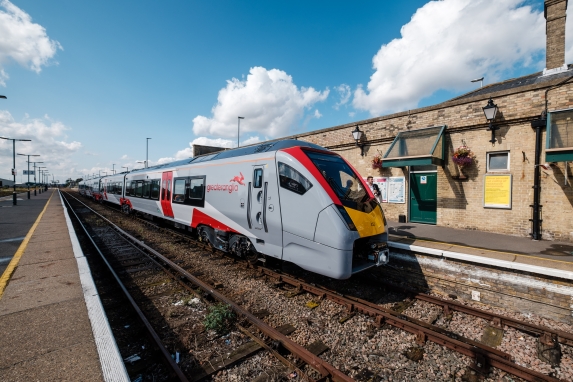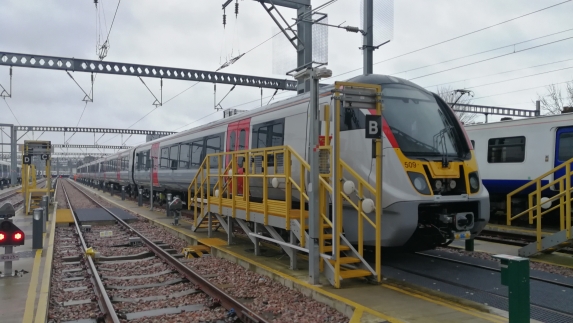Published on: Tuesday, 4 February 2020
Last updated: Monday, 9 March 2020
We’ve successfully run thousands of services, covering hundreds of thousands of miles using our new trains since we introduced them in July last year – and they are already making a positive difference to our customers’ journeys. The most common reaction we see when people step on board them for the first time is “wow!”. People like the fact that there’s more seats, plug and USB sockets, good air conditioning & heating and easier access – especially for those with a wheelchair, buggies or heavy luggage. But we also recognise that there have been some problems which have led to delays and sometimes cancellations. We are very sorry if you have been inconvenienced by these issues.
The first thing to say is – it’s not unusual for new trains to have some teething problems or glitches, but once they bed in, reliability and performance go up.
Trains do not roll off a production line. We’re buying 169 trains in total, from two different manufacturers, whereas the most efficient car factory makes 115 cars an hour. A train doesn’t come off the shelf and ready to roll into passenger service. Our trains are tailor-made for our passengers’ requirements. They have to work on our infrastructure – tracks, signals, points, overhead wires and so on – across every route – which is a great deal more complicated than taking a car onto the road. It is normal for new trains to experience a few glitches as they run in.
We are already seeing reliability starting to improve in Norfolk, where the new trains have been bedded in and used in passenger service for the longest.
In December, there were extensive delays and cancellations on our rural lines in Norfolk, Suffolk and parts of Cambridgeshire. These were not related to the new trains. We were asked by Network Rail to run fewer trains while signalling issues were investigated. We assisted fully with the investigation, which looked at the impact of extreme autumn conditions on the signalling system, the components of the signalling system itself and interaction between trains, new and old, and the track. Our investigation found that the issues were not related in any way with the design and performance of our new trains, which had been running successfully since July.
An advantage of the hi-tech nature of our new trains, is that if they do appear to develop a fault, in some cases it’s quicker to fix it.
Our new trains are controlled by sophisticated software, which is updated regularly – rather like the operating system on a smartphone. With each update, glitches or bugs are ironed out and better functionality installed. That’s not to say that every single fault is software-related. Modern trains are extremely complex and as well as high levels of software interaction, there are over a million components per train. We carried out hundreds of miles of “fault-free running” during the testing phase to ensure that any manufacturing defects were minimised.
We’re working very closely with Stadler, the manufacturer of our new trains which are already in passenger service, to improve reliability. They have sent an additional team of engineers from their factory in Switzerland to help us improve performance as quickly as possible. Stadler technicians travel on trains during their first few days in passenger service so that they are on hand to support Greater Anglia staff resolve any hitches that occur quickly and efficiently.
These trains are new to us, and the UK, but they operate reliably in 41 countries around the world, and we are fully confident they will help to positively transform rail travel in East Anglia.
So when will your new trains be more reliable?
The reliability and performance of our new trains is already getting better – thanks to our joint action plan with Stadler. Each new software update is reducing the number and frequency of faults. We’re also keeping a close eye on all the processes involved in getting our new trains into service and adjusting them if necessary. In coming weeks, we should see reliability and performance continue to improve. Since mid-January, punctuality on the Norwich-Sheringham line has been 97.5 per cent – which shows what’s possible.
What about the trains you’re getting from Bombardier – they’re not even here and aren’t there already problems?
The trains we’re getting from Bombardier are due into passenger service later than originally planned, which Bombardier says is due to a range of factors, including that it has taken longer to develop and optimise the software that will run these sophisticated trains. Production has been ramped up and about a third of the carriages which will make up the 111 trains have now been made. The first train is now on our patch, ready for testing. You can read more about that here . We can’t wait to get these trains into service, as they are top of the range for their class and will really improve journeys, especially on our very busy commuter routes.
Over the last year, we have gained a great deal of experience of introducing brand new trains into passenger service, and we will use that experience as we continue the rollout of our new trains in Essex, Cambridgeshire and Hertfordshire over the next year.
All our new trains are longer, with more seats, USB and plug sockets, air conditioning, free fast wifi, and improved passenger information screens, as well as toilets that collect all waste rather than dumping it on the tracks. They are replacing trains which are up to 40 years old, many of which came to the railway in East Anglia second-hand. They can accelerate faster, they’re quieter and smoother and have many green features. We are absolutely confident that once we’ve introduced them and they have settled in, they will prove more reliable than our old trains and enable us to offer a more punctual service to help you get to work, school, university or to spend some leisure time in the many beautiful and interesting locations on our network.
You can find more information about new trains here and don’t forget to check out our YouTube channel.




